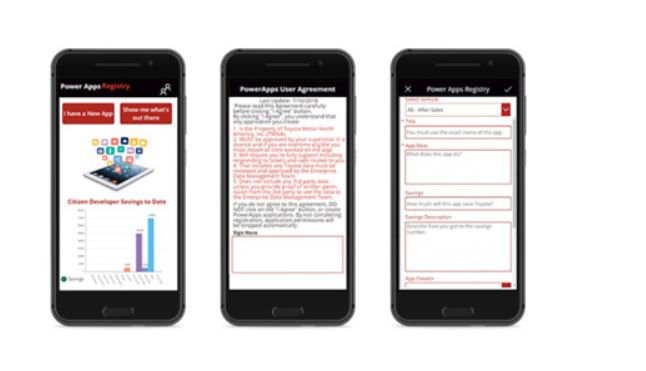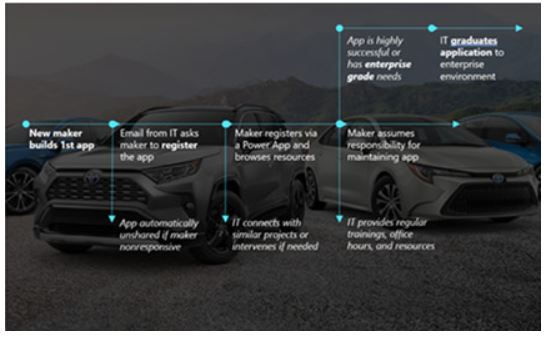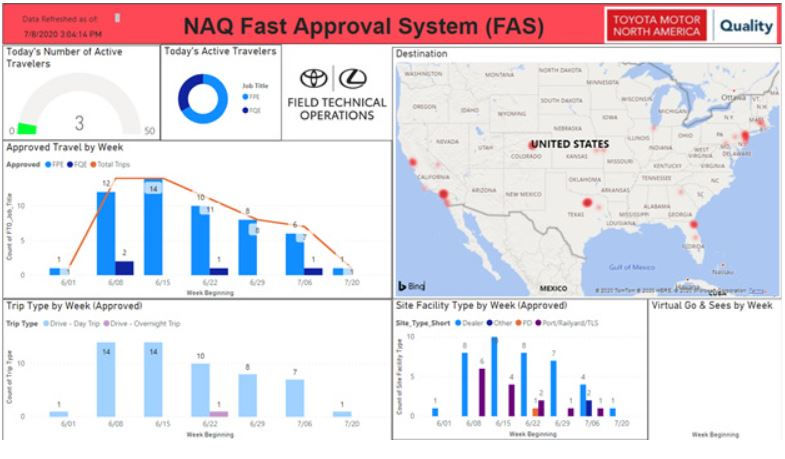Toyota Motor North America (TMNA) actively encourages employees to contribute to corporate innovation, and the company has given them access to Microsoft Power Platform for no-code and low-code development of business solutions. Employees have used Power Apps to create more than 400 apps that help with everything from product quality control to COVID-19 screening. To manage all this development, TMNA created a Center of Excellence that trains and supports employee efforts, and the company maintains rigorous governance requirements for app development.
Helping employees power corporate improvement with Power Platform
At Toyota Motor North America (TMNA), respect for people is a key pillar of the corporate culture and part of The Toyota Way. The company tries to ensure that any new technology it implements has a positive impact on its team members’ work processes and their ability to contribute to the company’s success in delivering ongoing quality for its customers. TMNA also encourages and empowers employees to stretch the boundaries of what they think they can do and come up with creative new ideas to solve business challenges.
The increasing popularity of no-code and low-code development solutions fits well with the TMNA philosophy by democratizing development knowledge and helping both professional coders and non-developers quickly create and iterate on applications that may be designed to help an individual, a department, or an entire enterprise work more efficiently and effectively.
At TMNA, a wide range of employees use Microsoft Power Platform—composed of Power Apps, Power Automate, Power Virtual Agents, and Power BI—to solve business problems that range from ensuring safety compliance to managing travel during COVID-19. The company has even created a Center of Excellence designed to foster, facilitate, and manage Microsoft Power Platform use and development. The Center offers classes, question and answer sessions, and individual training on how to make the best use of Microsoft Power Platform in different ways, whether that’s optimizing work with Power BI or building the next great app with Power Apps. Tim Holman, Enterprise Architecture Business Intelligence, TMNA, is head of analytics for the Center, and he’s seen it show positive results from the start.
“We’ve trained thousands of people since our inception,” he says. “I remember one employee in our very first training class who went back and translated the Excel spreadsheets she’d been using for years into Power BI dashboards. That switch saved her 10 hours of work every month.”
Those thousands of trained employees have now become knowledge ambassadors who can go out and promote to their peers the Center’s message of individual empowerment and self-service. “That’s really our goal with the Center,” explains Holman. “To educate all those employees so they can do things on their own, knowing that they have our support as a safety net if they need it.”

Figure 1. Power Apps registry for TMNA app developers; for larger versions of all the figures in this story, go to the Downloads section of the left-hand sidebar
Empowering employees while maintaining standards TMNA understands that all this development freedom requires guardrails that control access to sensitive data and ensure that only applications that meet certain quality standards become available for widespread use. TMNA has developed a set of policies that actively encourage development without letting it get out of control, since that could result in duplicated functionality or a confusing sprawl of applications. An employee interested in developing a new app must first register the app through a registry application and sign an app maker agreement. Once an app is registered, it goes through five rounds of approvals, starting with the employee’s manager and extending through the department’s vertical and a solution architect. The approvers make sure that the app provides unique functionality so that potential users aren’t confused about which app to use. The solution architect can look across all verticals to ensure company-wide quality control. The approvers also evaluate data access and security.
“We work closely with our internal cybersecurity and legal groups, and we’ve done a lot of vetting of the Microsoft Power Platform tools and our processes,” says Holman. “We want to do the right thing for our team members from a privacy perspective and also protect the company’s sensitive information.” If an app isn’t approved, the developer can still continue working on it as an educational project, but the Center has set up automated rules that prevent sharing the app with others. The company also monitors analytics about the use of apps and decommissions those that have reached their end of life based on a considerable drop in usage. If an employee does successfully publish an app, part of the app maker agreement is that that employee is responsible for support. For general app development support, however, all employees can turn to the Center of Excellence. The Center’s team members can help employees add new functionality they might not be able to build on their own. The Center’s team members don’t create the app for them, but the team members nurture and educate them as necessary. If the app is highly successful and meets enterprise-grade needs, it can graduate to an enterprise environment where it has a higher profile and access to increased development resources. Ultimately, the goal for the Center of Excellence is to make 80 percent of the employee Microsoft Power Platform development work self-service. “We’ll get involved when something is very complex, needs to be delivered very quickly, or involves some sort of compliance activity,” says Holman. “But whenever possible, we want employees to be able to do it themselves—whether that’s in our manufacturing plants, distribution centers, or other locations.”

Figure 2. TMNA Power Apps governance process
Building applications for a wide range of uses TMNA employees—whether professional developers or non-developers—have created more than 400 apps that are used throughout the company. Some apps are long-term solutions, while others are custom developed to solve time-sensitive issues, including the company’s response to COVID-19. “You can’t get into one of our facilities without using one of our Microsoft Power Platform apps,” says Holman. “These include a questionnaire app that tracks whether someone isn’t feeling well and another app that monitors the ongoing status of an employee who has potentially been exposed to COVID-19. We’ve also created more than 90 Power BI dashboards related to COVID-19.” Another employee-developed app created in response to COVID-19, Toyota Fast Approval System (FAS), uses Power Automate and Microsoft Forms to track and approve employee field visits and ensure that all travelers are comfortable with current travel requirements. With only a one-day introduction to Microsoft Power Platform, TMNA Field Product Engineer Josh Smith created and deployed the app in just two weeks. And its use quickly expanded beyond the original intended audience—it was intended for a single team but went division-wide before it even launched. In keeping with the spirit of putting the bulk of the work into the hands of employees with subject-matter expertise, a coworker created an accompanying Power BI dashboard for executive insight into travel locations and status, and another coworker used Power Apps to create an app for contact logging during approved travel.

Figure 3. Travel reporting for the Fast Approval System ensures visibility into the status of all traveling employees
Christopher Hitt, Assistant Manager – Field Technical Operations, TMNA, is another successful Power Apps developer. He sees Power Apps as a great way for subject matter experts to take an active role in solution creation.
“I manage a team of engineers, and they aren’t IT people, but they have a great knowledge of how cars work and what needs to be done to ensure customer satisfaction,” he says. “When we need an app, I could hire computer scientists, but they wouldn’t have the necessary domain knowledge. With Power Apps, my team can quickly build systems in-house without allocating extra budget for outside help. From there, we can continuously improve those systems, which is the Toyota Way.”
Hitt’s team has used Power Apps to more quickly identify and address quality issues that dealerships are seeing with new cars in the field. Hitt estimates that by capturing the necessary information, consolidating reports, and connecting the relevant departments within the company, his team has cut the time from first incidence of an issue to the first actionable report by 98 percent. This directly affects the customer experience by ensuring that issues are addressed correctly and quickly.
“As we strive to produce and deliver ever-better vehicles, Microsoft Power Platform has empowered our team to digitally transform our day-to-day responsibilities, resulting in higher quality and safety. We now have the ability to take better care of our customers as we design, build, and implement solutions as a team,” say Hitt.
TMNA has even extended Power Apps development with Microsoft Azure Cognitive Services and Azure Machine Learning to create an accessory installation app that uses Computer Vision to look at vehicles and determine whether they are equipped with the appropriate equipment and whether that equipment is in the desired condition.

Figure 4. Accessory installation app for equipment quality checks
“This has been a huge leap forward for us,” says Hitt. “We used to do very targeted surveys with small samples because it was a time-consuming process. With Power Apps, we’re able to go from surveying 5 percent of our dealers to surveying 100 percent of our dealers, which is a tremendous productivity gain. We can also display results in real time in Power BI so that dealers and regional teams know where they need to follow up.”
Reflecting on the advantages of low-code development
For Hitt and his team, Power Apps offers a compelling alternative to the traditional practice of outsourcing solution development to corporate IT teams. “It’s not so much a matter of reducing costs—it’s more about development velocity and actually getting things built, rather than worrying about justifying the use of IT resources,” says Hitt. “From an innovation standpoint, we can use Power Apps to spec and build a solution and continuously improve it, rather than waiting for someone else to do the work.”
For Holman, Microsoft Power Platform is a great way to bring developers and data scientists of all experience levels together with tools that can help them achieve personal goals while simultaneously driving value for the company. “We want people to understand that they don’t need a PhD to build a valuable solution and solve important business problems,” Holman says. “With Microsoft Power Platform, we’re reducing the time people need to get answers to their questions, which makes us all more effective and efficient. And the Center of Excellence is there to help them get started and ensure that they succeed.”

Comments